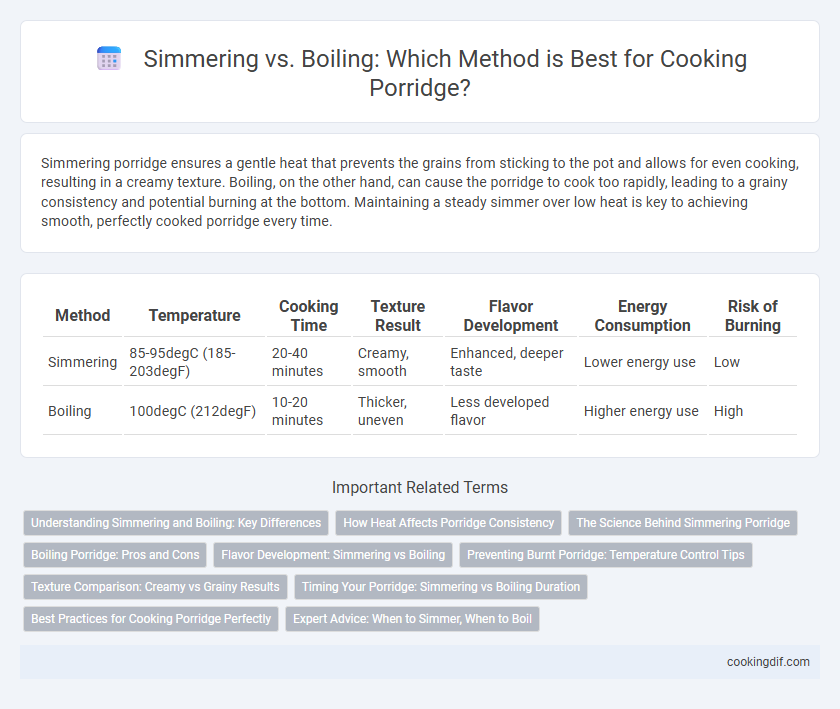Simmering porridge ensures a gentle heat that prevents the grains from sticking to the pot and allows for even cooking, resulting in a creamy texture. Boiling, on the other hand, can cause the porridge to cook too rapidly, leading to a grainy consistency and potential burning at the bottom. Maintaining a steady simmer over low heat is key to achieving smooth, perfectly cooked porridge every time.
Table of Comparison
| Method | Temperature | Cooking Time | Texture Result | Flavor Development | Energy Consumption | Risk of Burning |
|---|---|---|---|---|---|---|
| Simmering | 85-95degC (185-203degF) | 20-40 minutes | Creamy, smooth | Enhanced, deeper taste | Lower energy use | Low |
| Boiling | 100degC (212degF) | 10-20 minutes | Thicker, uneven | Less developed flavor | Higher energy use | High |
Understanding Simmering and Boiling: Key Differences
Simmering occurs at a temperature just below boiling point, typically around 185degF to 205degF (85degC to 96degC), where small bubbles gently rise to the surface, preserving texture and preventing burning. Boiling reaches 212degF (100degC), causing vigorous bubbles and rapid evaporation that can break down porridge grains and lead to uneven cooking. Understanding these temperature differences ensures optimal porridge consistency, with simmering favored for creamy, smooth results and boiling often causing a mushy texture.
How Heat Affects Porridge Consistency
Simmering porridge maintains a gentle heat that allows starches to gradually absorb water, resulting in a creamy, smooth consistency without sticking or burning. Boiling introduces higher temperatures that cause rapid starch gelatinization but can break down the texture, making the porridge thicker and lumpier. Controlling heat intensity during simmering ensures optimal viscosity and prevents separation, preserving the desired creaminess.
The Science Behind Simmering Porridge
Simmering porridge maintains a temperature just below boiling point, typically around 85-95degC (185-203degF), which prevents the starch granules from rupturing violently and creating a smoother, creamier texture. The gentle heat allows starch molecules to gelatinize gradually, optimizing water absorption and thickening without the risk of scorching or overcooking. This controlled process results in a consistent porridge consistency, enhanced flavor development, and nutrient retention compared to the aggressive agitation caused by boiling.
Boiling Porridge: Pros and Cons
Boiling porridge rapidly cooks the grains, reducing overall cooking time and creating a thicker texture by concentrating the starches. However, excessive boiling can cause the porridge to stick to the pot, burn easily, and lose some nutritional value due to high heat exposure. Balancing boiling with gentle simmering ensures a smoother consistency and preserves the flavor and nutrients of the porridge.
Flavor Development: Simmering vs Boiling
Simmering porridge allows gradual starch gelatinization, resulting in a creamier texture and enhanced flavor complexity. Boiling porridge agitates the grains vigorously, causing uneven cooking and a starchy, less nuanced taste. Maintaining a gentle simmer optimizes flavor development by promoting consistent heat absorption and delicate moisture evaporation.
Preventing Burnt Porridge: Temperature Control Tips
Simmering porridge at a low temperature between 185degF and 205degF prevents burning by allowing gradual heat absorption and even cooking. Stirring frequently while maintaining a simmer keeps the grains from sticking to the pan's bottom, reducing scorch marks. Using a heavy-bottomed pot improves heat distribution, minimizing hot spots that cause burnt porridge.
Texture Comparison: Creamy vs Grainy Results
Simmering porridge produces a creamy, smooth texture as the gentle heat allows the grains to absorb water evenly and break down gradually. In contrast, boiling porridge creates a grainy texture due to rapid agitation that prevents the grains from softening uniformly. This difference in cooking method significantly impacts the mouthfeel and overall eating experience.
Timing Your Porridge: Simmering vs Boiling Duration
Simmering porridge allows for slow, even cooking, typically requiring 20 to 30 minutes to achieve a creamy texture without burning, while boiling speeds up the process but risks uneven thickness and sticking. Boiling porridge usually takes 10 to 15 minutes but demands constant stirring to prevent lumps and scorching. Choosing simmering over boiling ensures optimal absorption of liquid and enhances the porridge's smooth consistency.
Best Practices for Cooking Porridge Perfectly
Simmering porridge preserves a creamy texture and prevents scorching, as it allows gentle, even heat distribution essential for grains to absorb liquid properly. Boiling can cause the porridge to cook too rapidly, leading to uneven consistency and potential burning at the bottom of the pot. Maintaining a low, steady simmer and stirring frequently ensures perfectly cooked porridge with optimal thickness and smoothness.
Expert Advice: When to Simmer, When to Boil
Simmering porridge allows for gentle heat that prevents scorching and promotes creamy texture, ideal during the initial cooking phase to fully soften grains. Boiling is recommended briefly at the start to bring ingredients quickly to temperature, then reduced to a simmer to maintain consistent cooking without overflow or burning. Experts emphasize controlling heat transitions between boiling and simmering to achieve perfect porridge consistency and flavor balance.
Simmering vs Boiling for Cooking Porridge Infographic

 cookingdif.com
cookingdif.com